Inbox
Move idea from "Submission" stage to:
Do you want to send this idea to AdaptiveWork?
Do you want to send this idea to Portfolios?
Which workspace template do you wish to use?
on
Technologies and behaviors to clean up our waters
In this work we propose solutions for the collection of plastic in rivers and the consequent possible reuse. Today, plastic pollution represents one of the most serious environmental emergencies for our planet and for the species that inhabit our oceans. The plastic that ends up in the sea, over time, divides into small fragments until it becomes "microplastic". The material made up of these micro fragments is harmful to the entire ecosystem, marine and otherwise; just think that fish ingest plastic and those that do not die end up in the food chain of other species, including that of humans. Considering that today there is a certain attention to nutrition, resorting to healthy and personalized diets characterized by the use of "bio" products, frightened by the news on intensive animal breeding, to eliminate even the consumption of fish would not seem a bad idea (yet the restaurants where raw fish is served depopulate with their "all you can eat" offers). Unfortunately, most of the clothes we buy in chains of affordable clothing stores are also made of microplastics; there would be nothing wrong if the necessary precautions were taken during washing and if the garment, once it reached the "end of life", was properly disposed of and recycled. Washing synthetic fabrics is the main cause of the release of microplastics into the environment. This is evidenced by a study published on nature.com/scientificreports and edited by Francesca De Falco, Emilia Di pace, Mariacristina Cocca and Maurizio Avella (researchers of the Institute of polymers, composites and biomaterials - Cnr of Pozzuoli) which also indicates some ways to place remedy for this form of pollution. During the tests it was shown how the garments with yarns made of continuous filaments, high twist and low hairiness released less microfibres during washing. This could be an important indication to guide textile design for the clothing industries. In short, most of what surrounds us is made of plastic and if you think that not all plastics are recyclable, it goes without saying that recycling alone is not enough.
Then, in the advanced proposals, we will talk about "circular economy", an economic system planned to reuse materials in subsequent production cycles, reducing waste to a minimum. The solution we propose is based on the integration of multiple technologies, both existing and non-existing. We have also diversified our solutions based on whether the river is navigable or not.
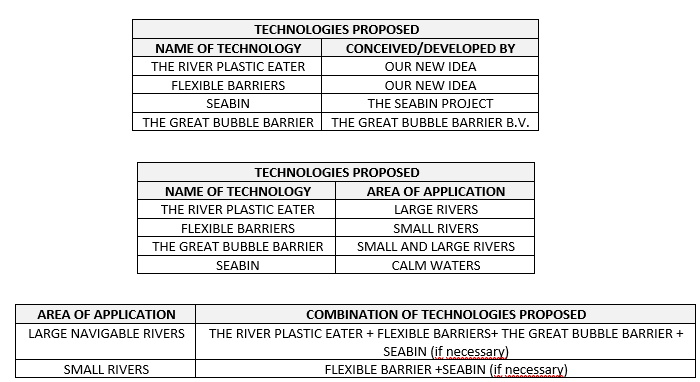
Large navigable rivers - The River Plastic Eater
One (or more) River Plastic Eater, catamarans placed at a distance of tot km arranged transversely, capture the plastic. The catamaran is equipped with proximity sensors that allow it to avoid impacts, and depth sensors. It works completely on solar energy and is made with recycled material. It moves in the water following an optimal path thanks to an integrated GPS system. When it is full, it goes to the nearest collection point for emptying. The emptying of the catamaran in the stations along the route does not take place at regular time intervals, but in function of collected plastic, so as not to cause overloading or unnecessary emptying. Sensors monitor the fill level and plan intelligent collection. The emptying of the catamaran is automatic, when the collection station is full, the collected material will be transported by two operators to the disposal center.
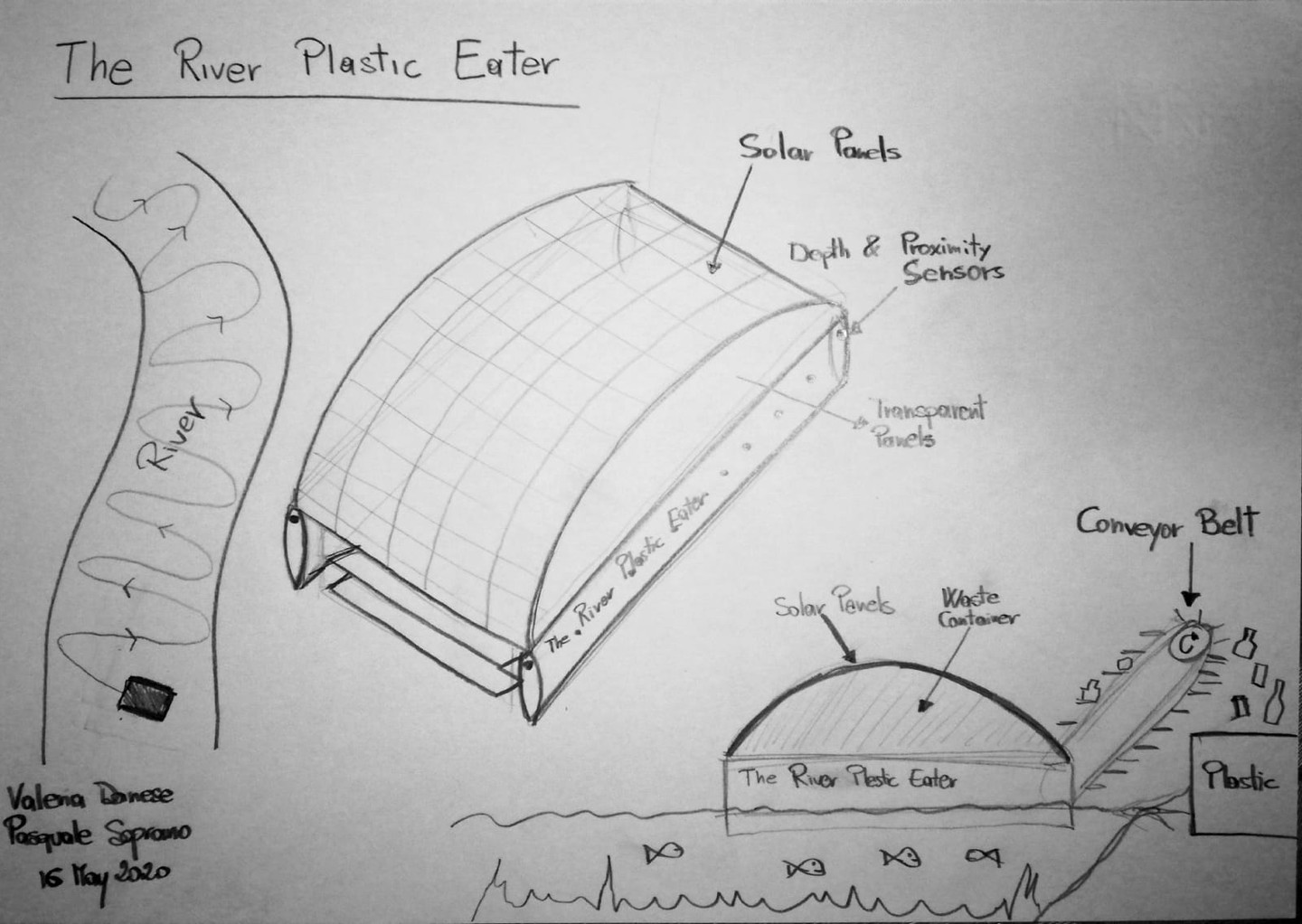
Small rivers, tributaries, non-navigable points of large rivers (very shallow waters) - Flexible Barriers
If you want to prevent plastic from reaching the seas by intercepting it upstream, then from rivers, the same can be said of large rivers, where the arrival of plastic through its tributaries can be prevented. This second proposal concerns the use of Flexible Barriers (always made with recycled plastic) immersed up to a certain depth and placed at a certain distance between them in order to allow the use of the river by small boats and without compromising the regular development of flora and fauna. The barriers convey floating waste to precise accumulation areas. These barriers have the shape of a segmented belt. The barriers convey floating waste to precise accumulation areas by exploiting the natural currents of the waters. A conveyor belt conveys the waste to the containers of the collection stations on the banks of the rivers. Periodically the accumulated material is collected and destined for subsequent uses.
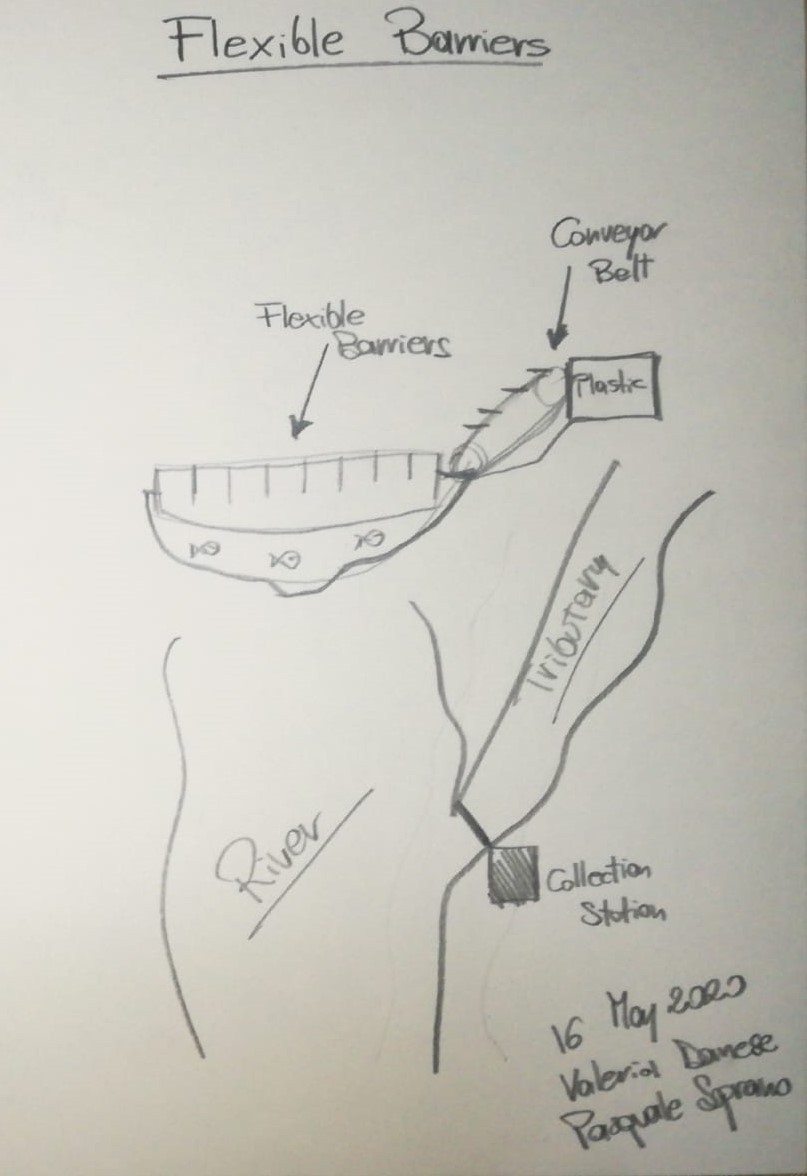
Recesses of rivers - Seabin
Seabins can be used in the recesses of rivers. The "Seabin" system was invented in Australia by two surfers and is a relatively inexpensive, simple and effective system (https://seabinproject.com/). The operation of "Seabin" is shown in the following image.
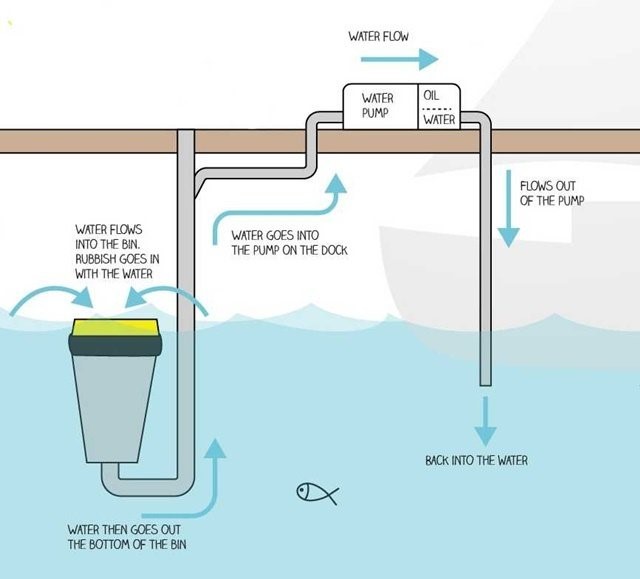
Seabin is a basket that contains a sort of empty filter inside. A pump is connected to the Seabin through a pipe that sucks the water into the filter and the waste with it (> 2 mm). The "purified" water is put back into the sea while the waste is retained in the filter which must be emptied periodically. In our opinion, improvements could be made regarding the implementation of sensors that signal the possible filling of the baskets before the expected emptying cycle and the operation of the pump through renewable energy. Moreover, Seabin is produced with recycled material. The devices installed in the world today are 860 and have collected more than 30 tons of waste. Each Seabin is able to collect on average 500 kg of plastic per year, (variable quantity based on the size of the waste). The cost of a Seabin (from the information found on the net) is around € 3300 (excluding taxes) and if, if you buy 100 pieces, the cost drops to around € 3000 (excluding taxes). Seabins can be installed by local administrations and the initial costs incurred can be amortized by selling the material collected over time. In Italy, for example, Seabins are also installed in the Milan canals and in the Venice canals.
Mouth of the rivers - The Great Bubble Barrier
Finally, our idea sees the use of the Great Bubble Barrier, a barrier that prevents plastic from flowing further, always allowing fish and ships to cross the barrier without obstacles. A bubble screen is created by pumping air through a tube with holes, located on the bottom of the waterway. The Bubble Barrier creates an upward thrust, which brings waste to the surface of the water. Positioning it diagonally in the waterway, the Bubble Barrier uses natural current to guide the plastic towards the collection system along the river.
The Great Bubble Barrier is a young and fast-growing Dutch start-up located in the north of Amsterdam (https://thegreatbubblebarrier.com/en/).
In the fall of 2019, the first Bubble Barrier was implemented which will remain in place for a long period of time in the capital of the Netherlands: Amsterdam! This Bubble Barrier was installed by The Great Bubble Barrier at one of the outlets from the canals into the IJ. With this the Bubble Barrier will prevent Amsterdam canal plastic from flowing into the North Sea. This is a global first in the fight against plastic pollution.
The Bubble Barrier was commissioned by the Amstel, Gooi and Vecht Water Management Board and the Municipality of Amsterdam as an extension of “Amsterdam Clean Water” which strives for clean plastic-free waters in Amsterdam. The location, the Westerdok, is one of the points where the water flows from the monumental canals of Amsterdam into the IJ. The IJ flows into the North Sea Canal and this leads directly to the North Sea. This makes Westerdok an ideal place to catch Amsterdam’s canal plastic.

These systems make it possible not to produce microplastics because the residence time of plastic in water is considerably reduced.
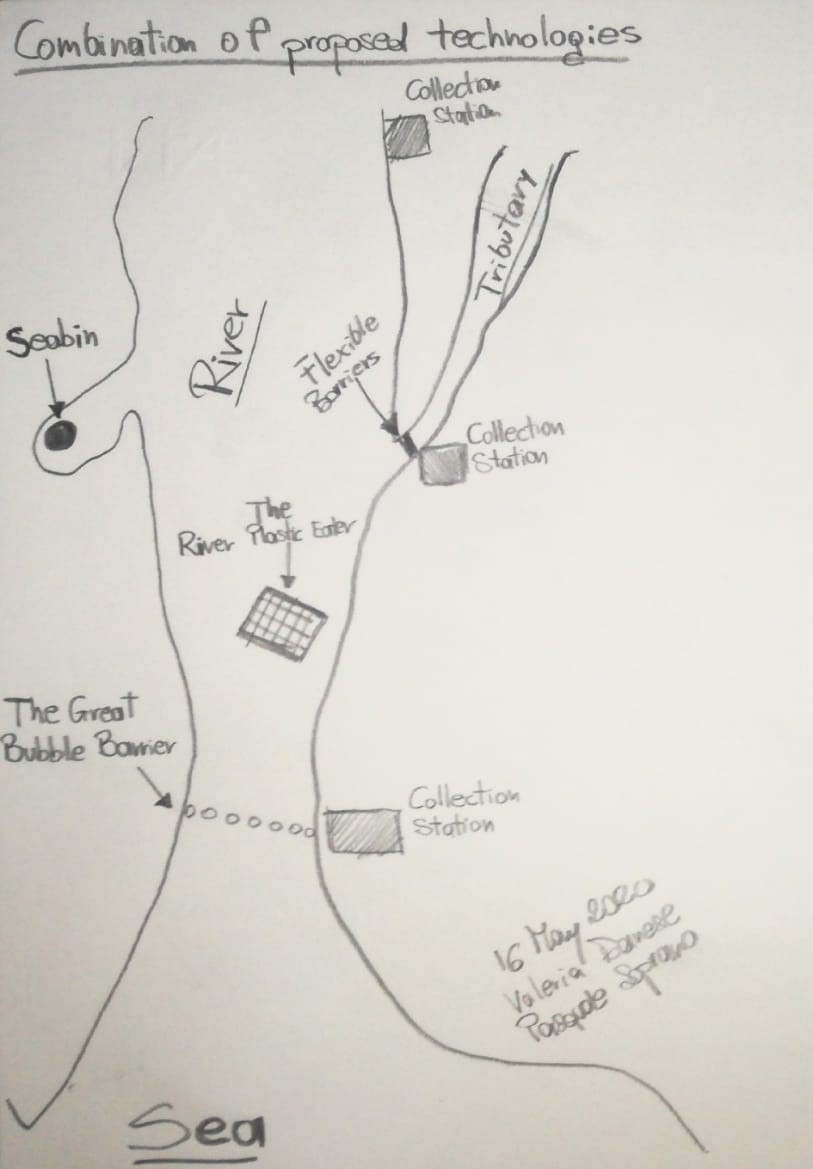
Ideas for the reuse of plastic
Our ideas for the reuse of plastic are numerous. We thought that once collected, plastic could be reused to build other devices for plastic collection. The collected plastic could be reused, for example, to produce the numerous components and furnishings within new boats. Moreover, numerous containers for recycling for public use could be produced to be installed in the city (in many surveys on recycling, the citizen claims to unjustifiably abandon waste on the ground due to the absence of containers or to throw them in any container in the absence of those for recycling), or for private use. Another sector where recycled plastic could be used is that of luggage. Plastic could also be used in the construction, transport and industry sectors; for the creation of flooring, pipes, elements for constructing ventilated crawl spaces, fixtures, concrete formwork, seats for stadiums and buildings, noise barriers, athletics tracks, road paving. In the electronics industry, recycled plastic could contribute to the construction of PC, printers, mouse. Even in the automotive and aeronautics sectors, plastic could be used for internal components and fittings.
As reported by the study carried out by Istituto Oikos Onlus, as much as 80% of plastic waste in Italy derives from packaging. Obviously the quantity of packaging is to be drastically decreased, new solutions must be found but the collected plastic could be used precisely for the packaging that you really cannot do without.
Conclusions
At the conclusion of the proposals made in this work, we can certainly say that the theme of plastic in water (and of waste in the environment in general) is one of the main themes with which humanity has and will have to deal, if it still wants continue to inhabit the planet Earth. Moreover to the scientific community, an increasing number of artists are also committed to this issue. Humanity is not the only living species to inhabit the planet Earth, but because of us, other species are already paying a heavy bill (see extinction), a (non-economic) account that will soon become very heavy for humans too. Before us, in fact, who do not live underwater and do not feed only on what we find in the sea, the species that inhabit it exchange plastic for food, going, most of the time, to meet death. We should acquire greater awareness and start in our small way through small gestures that may seem trivial to each of us, but which in sum would make a great difference. Most of the plastic produced is disposable and recycling of plastic alone cannot be enough; its production and use should be limited, try to collect as many as possible and transform it into durable goods. As the seas, rivers, lakes and waters of the entire planet are global common goods, policies of global dimensions would be needed, with initiatives aimed primarily at sensitizing citizens and drastically decreasing the production of disposable plastic. Furthermore, such policies could paradoxically transform this negative situation into a positive one, going to exploit a real economic business in creating solutions, collecting and transforming plastic, also creating numerous job opportunities.
Valeria Danese and Pasquale Soprano
Existing solutions --> 1) https://seabinproject.com/ - 2) https://thegreatbubblebarrier.com/en/
Combination of existing technologies and new technologies --> https://www.youtube.com/watch?v=Jp-52jS3M-c

Help to Improve This Idea.